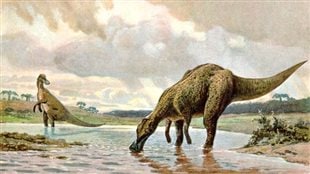Millions of years ago, it was a dino eat dino world.
At the top of the food chain, the fearsome meat-eating T-rex, massive, powerful, fast, with jaws loaded with giant flesh ripping teeth. On the other side, plant-eating hadrosaurs, no armour plating, no sharp defensive claws, spikes, long tusks or horns, not light and speedy, and, too big to hide.
Scott Persons, a PhD candidate at the University of Alberta’s Dinosaur Laboratory studied how the apparently defenceless hadrosaurs not only survived, but thrived while living side by side with T-rex and it’s cousins.
Listen
It seemed like somewhat of a survival mystery.
Hadrosaurs were among the most common dinosaurs in environments all around the prehistoric world, yet co-existed withT-Rex and members of that fearsome group and somehow managed to thrive without the deterrents of claws, armour, or other defences that other species developed to dissuade predators.
Hadrosaurs were social animals, but being part of an apparently defenceless herd would seem to mean simply a greater number of potential dinner animals to choose from for T-rex.
Persons and University of Alberta renowned dinosaur expert Phil Currie, wanted to study this survival mystery.
They found the answer may lie in part with the creatures leg muscles.

Using computer modelling and analysis of dinosaur fossils,and careful examination of modern reptiles, Persons, and Currie, studied muscle size and attachments and found some important discoveries and different survival strategies between hadrosaurs and T-rex.
They discovered that although both species would have had supersized main leg muscles, they were attached high on the thigh on T-rex, and low on hadrosaurs.
This gave T-rex quicker, longer strides but like a short-lever, that requires a lot of energy to move the leg, so the muscles tire more quickly.
The hadrosaur main muscle, although also supersized, was attached lower on the thigh, so leg movement was not as fast, but like a long lever, required less effort and so the muscle could go through many more contractions before tiring, meaning the animal could travel further.
Persons says it’s a situation rather like modern cheetahs and zebras, in that T-rex, like a cheetah, could run faster but not for long, whereas the zebra, or hadrosaur was not quite as fast but could run much further.
What that meant is that a herd or even just a family of the plant eaters, with several eyes, ears, and noses all constantly checking for an approaching predator, could begin running before T-rex got within its effective striking range, and so retreat to a safe distance from the toothy danger.

Additionally, it’s thought that unlike cheetahs or lions which can crouch low sneak up close to a herd through the tall grass, it would have been somewhat more difficult for T-rex, the size of a large truck, to stealthily sneak up on hadrosaurs through the marshes and forests of some 70 million years ago..
Persons, lead author, and co-author Currie have published their findings in a new paper on tyrannosaur avoidance strategies which was released this week in a special compendium of research papers on hadrosaurs produced by Indiana University Press.







For reasons beyond our control, and for an undetermined period of time, our comment section is now closed. However, our social networks remain open to your contributions.